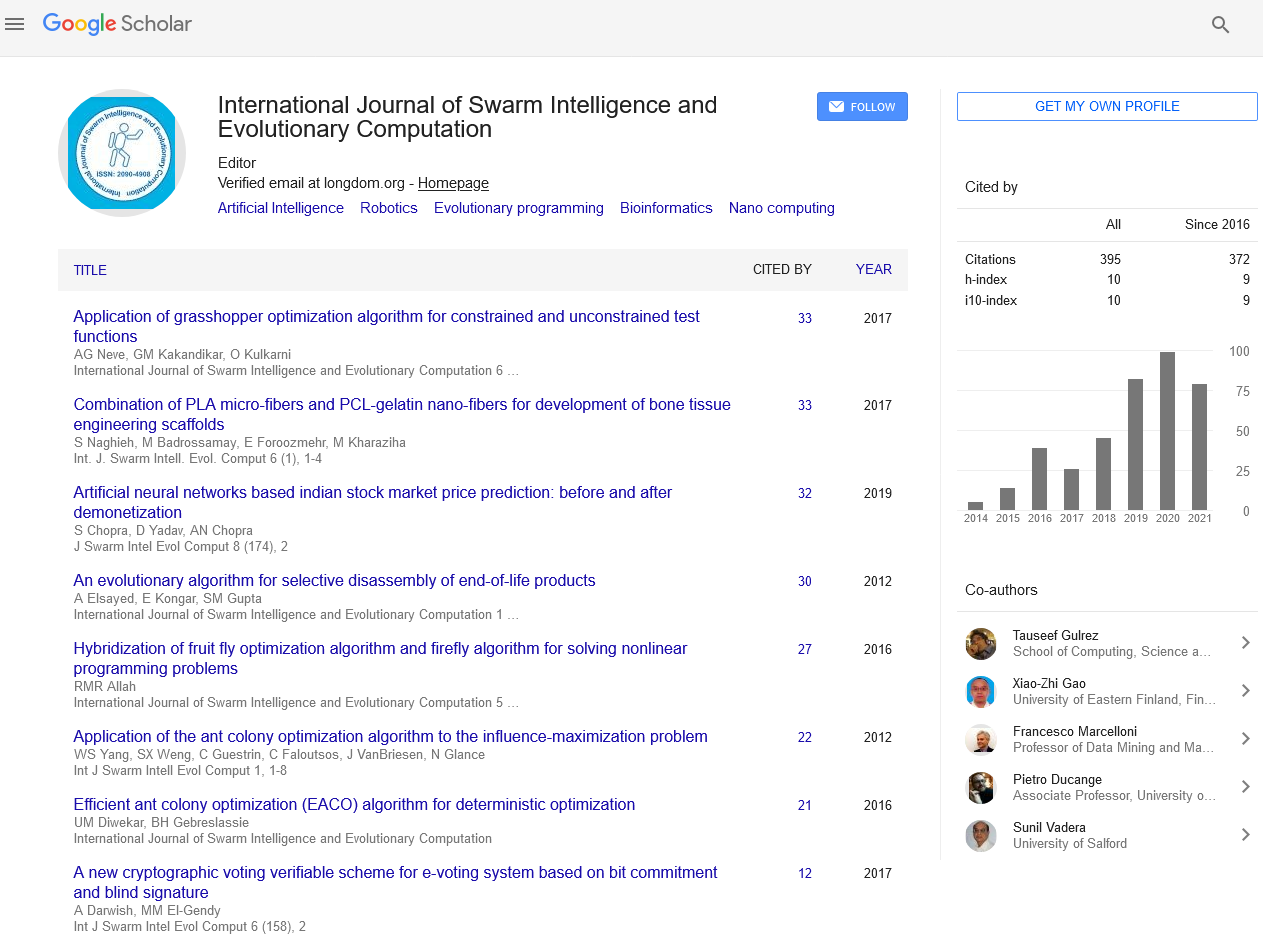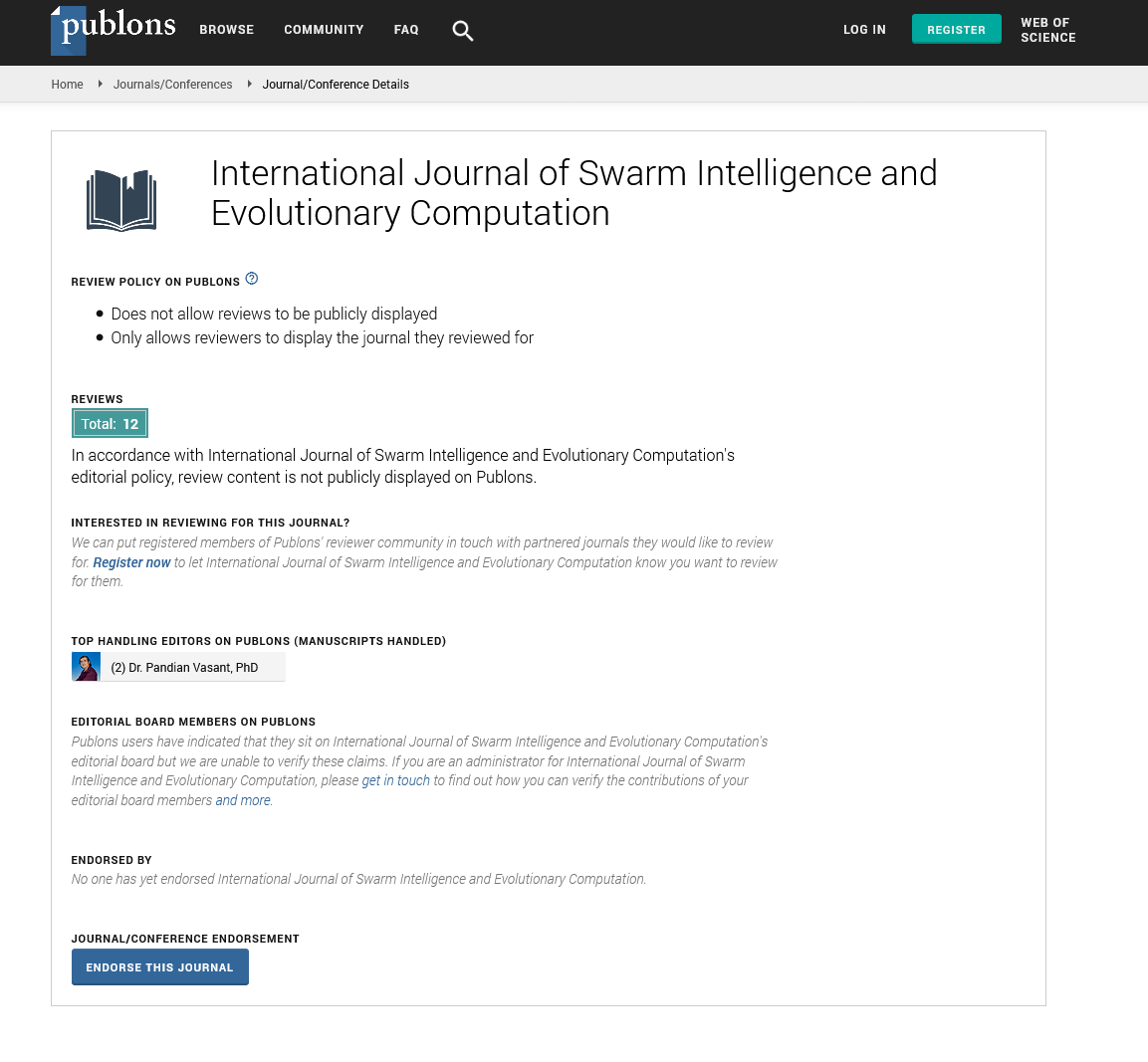Indexed In
- Genamics JournalSeek
- RefSeek
- Hamdard University
- EBSCO A-Z
- OCLC- WorldCat
- Publons
- Euro Pub
- Google Scholar
Useful Links
Share This Page
Journal Flyer
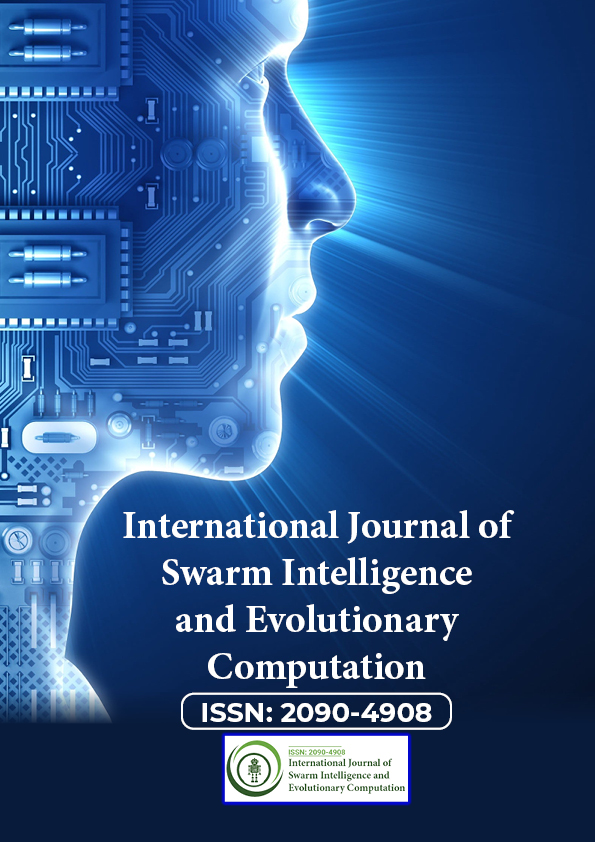
Open Access Journals
- Agri and Aquaculture
- Biochemistry
- Bioinformatics & Systems Biology
- Business & Management
- Chemistry
- Clinical Sciences
- Engineering
- Food & Nutrition
- General Science
- Genetics & Molecular Biology
- Immunology & Microbiology
- Medical Sciences
- Neuroscience & Psychology
- Nursing & Health Care
- Pharmaceutical Sciences
Research Article - (2024) Volume 13, Issue 3
Improving Online Livestock Health Monitoring System using Machine Learning, AI, ANN, IoT and Sound Based Technologies: A Pilot Study
Mohsen Sotoudeh*, Nahal Alavi and Ali ZarrinehReceived: 27-Apr-2024, Manuscript No. SIEC-24-25580; Editor assigned: 29-Apr-2024, Pre QC No. SIEC-24-25580 (PQ); Reviewed: 14-May-2024, QC No. SIEC-24-25580; Revised: 22-May-2024, Manuscript No. SIEC-24-25580 (R); Published: 31-May-2024, DOI: 10.35248/2090-4908.24.13.369
Abstract
In the livestock industry, maintaining the health of animals is very important, and the use of technology has greatly helped this. One of the existing challenges has been that most of the available sensors and electronic processing devices are designed to fit the human body, and the use of these devices for livestock faces limitations due to the difference in the structure of the body and skin of animals and humans. Reliable solutions tailored for animal husbandry can be achieved by modifying the physical and software structure of existing devices.
In this article, we have presented the current situation, by reviewing the research done and the existing technology in the field of animal husbandry. The aim is to obtain comprehensive parameters for monitoring livestock health by leveraging available information and exploring new methods based on the Internet of Things (IoT), Artificial Neural Networks (ANN), and Artificial Intelligence (AI). We take a proactive approach by utilizing available technologies based on sound-based diagnostic techniques.
Initially, we propose utilizing piezoelectricity and amplifying received sound using a diaphragm attached to a collar. Subsequently, we discuss the results of relevant tests that can be conducted using the phonocardiography system.
For the next phase of research and designing a more advanced livestock health monitoring system, we suggest employing an ultrasonic system to measure heart rate and blood pressure for the next phase of research and designing a more advanced livestock health monitoring system. This system, coupled with a piezoelectric system to make electric energy from the pulse of the veins, could be subcutaneously implanted for continuous monitoring.
Keywords
Animal health; Smart collar; Livestock farming; AI; Modern animal husbandry; Livestock health, IoT-based technology
Introduction
Ever since humans discovered the power of agriculture and animal husbandry, there has always been a continuous progression. This progress has been reliant on monitoring the health of livestock and preventing diseases. With the ever-increasing population and human need for food, it becomes imperative to pay more attention than ever to the health and safety of the livestock farming industry. This ensures profitability for farmers, prevents migration of farmers to urban areas, and fosters appreciation for the valuable and beautiful animals known as livestock.
With appreciation and respect for all the services rendered by farmers, veterinarians, engineers, and researchers over the years, we aim to shed light on a small part of this history. Then, we will propose innovative methods that we hope will attract the attention of scholars and enthusiasts in this field. With mutual assistance, we hope to have a significant impact on the advancement of the livestock health monitoring industry.
Experimental background
Numerous diverse systems have been introduced for monitoring livestock health, making it impractical to cover all of them in a single article. Therefore, we will focus solely on the wireless sensor system on the cow collar, as the neck collar, due to its minimal discomfort for the animal, is the most widely used tool for livestock.
The best items that can be used for detecting animal health include: Body temperature, pulse or heart rate, respiration, feeding behavior, estrus detection, resting time, and sounds produced by the animal.
To remotely diagnose and systemically address some of these aspects, systems have been developed, and extensive research has been conducted to obtain newer, more confident, and higher- quality methods. Here, we distinguish and introduce the most important of them.
Existing systems
Devices designed for cattle collar usage, utilizing temperature and accelerometer sensors, have been able to provide valuable information about livestock health, including body temperature, feeding time, rumination, and cow resting time. Some of the above companies are: 1. www.gea.com 2. www.afimilk.com 3. www.allflex. co 4. www.artemishealth.io/ (Figure 1).
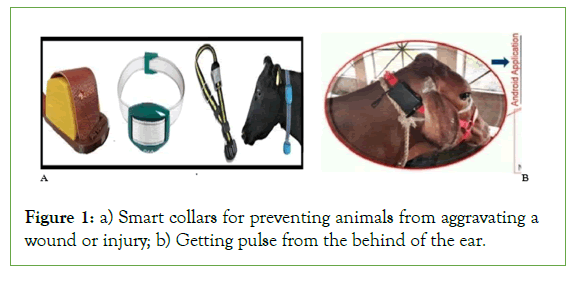
Figure 1: a) Smart collars for preventing animals from aggravating a wound or injury; b) Getting pulse from the behind of the ear.
Theoretical foundations
All the heart rate sensor modules available in the market are designed to be used on the human body, which work based on the light radiation and reflection system. Due to the difference in the structure of the skin of animals compared to humans, the use of these sensors for each type of animal requires special research and testing. To overcome this challenge, we looked for a different or complementary method, and extensive research is being done, some of the most important articles on this topic.
The main research in this article is related to the detection of pulse and heart rate because it is one of the most important factors for identifying diseases in livestock.
• In this article, the heart rate sensor kg 11 is used in the back of the cow’s ear, which is made of thinner skin [1].
• Indonesian University research on the use of a heart rate sensor on a cow’s neck collar [2].
• Using the human heart rate sensor on the sheep skin of the chest area. The heart rate is recorded, but for more certainty, there is a need to develop and use amplification algorithms [3] (Figure 2).
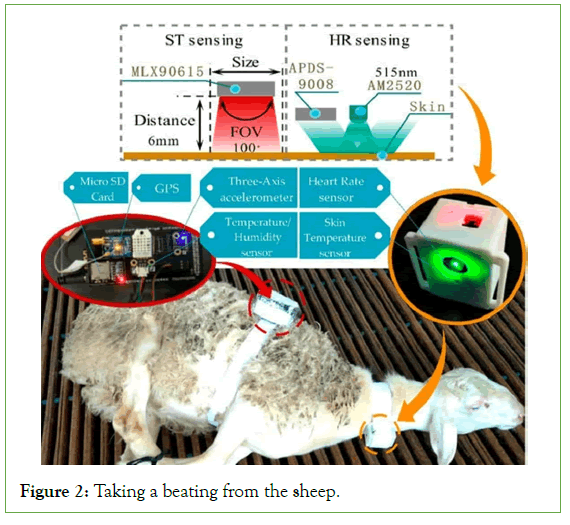
Figure 2: Taking a beating from the sheep.
• An article that reported about 72%-75% accuracy in 15 cow samples [4].
• An article that uses the combination of a human electrode device with a pulse sensor to improve and eliminate the weakness of the heart rate sensor on the cow’s abdomen and has achieved more accurate results [5] (Figure 3).
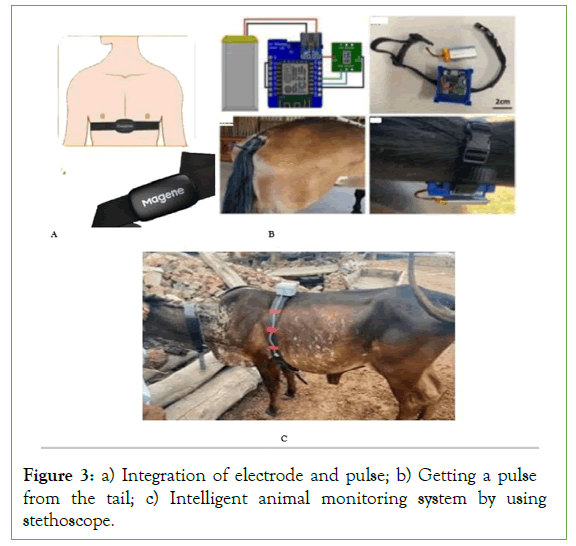
Figure 3: a) Integration of electrode and pulse; b) Getting a pulse from the tail; c) Intelligent animal monitoring system by using stethoscope.
• Research paper on the optical heart rate sensor on the end of the tail. Sponsor: University of Missouri [6] (Figure 4). In this interesting experiment, the sensors are tied by a belt around the cow’s body and a stethoscope is used to improve the quality of receiving the heartbeat [7].
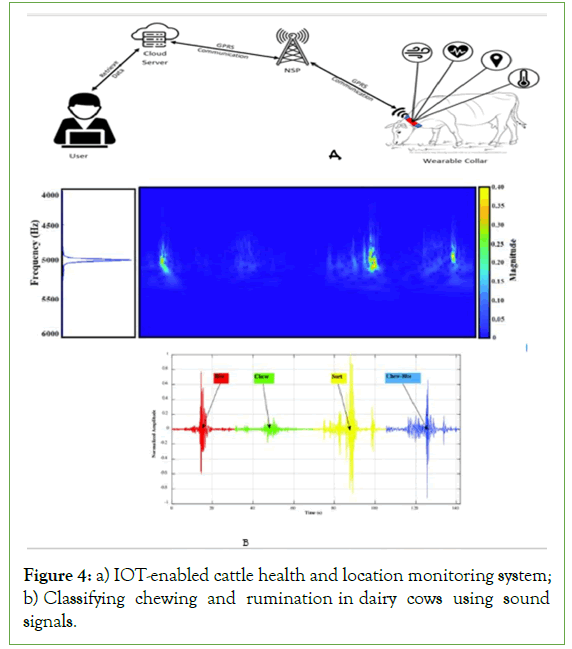
Figure 4: a) IOT-enabled cattle health and location monitoring system; b) Classifying chewing and rumination in dairy cows using sound signals.
• An article about analyzing the behavior of cattle feed using a sound sensor [8].
Abnormalities that cause a change in the animal’s heart rate
Based on the conducted research and considering the need for a reliable method for systemic monitoring of livestock heart rates, a definitive method for obtaining a cow’s pulse from the collar has not yet been introduced, given the requirement for the most convenient and wearable device for animals.
Abnormalities that may cause changes in livestock heart rate include: Cardiomyopathy, heart disease, therapeutic conditions, perfusion disorders, blood diseases, fever, respiratory diseases, infectious diseases, kidney problems, metabolic disorders, stress and anxiety, esophageal obstruction during food ingestion, swallowing of indigestible pieces, etc.
Materials and Methods
Examination of desirable situation
Among the factors that should be considered to achieve the desirable state in the livestock community are precise treatment scheduling, reduction of veterinary expenses, increased productivity, and enhancement of cattle health and safety through obtaining comprehensive and accurate information using digital tools and online communications. One of the best tools traditionally used in livestock farming is the collar, and we aim to gather more information from the sensor box attached to it. Currently, we have succeeded in utilizing temperature sensors, accelerometers, GPS trackers, thermometers, pedometers, gas sensors, and sound sensors. If we can devise a method for detecting heartbeat on the neck of the cattle, completing our livestock health monitoring module will lead to significant advancements in livestock breeding (Figure 5).
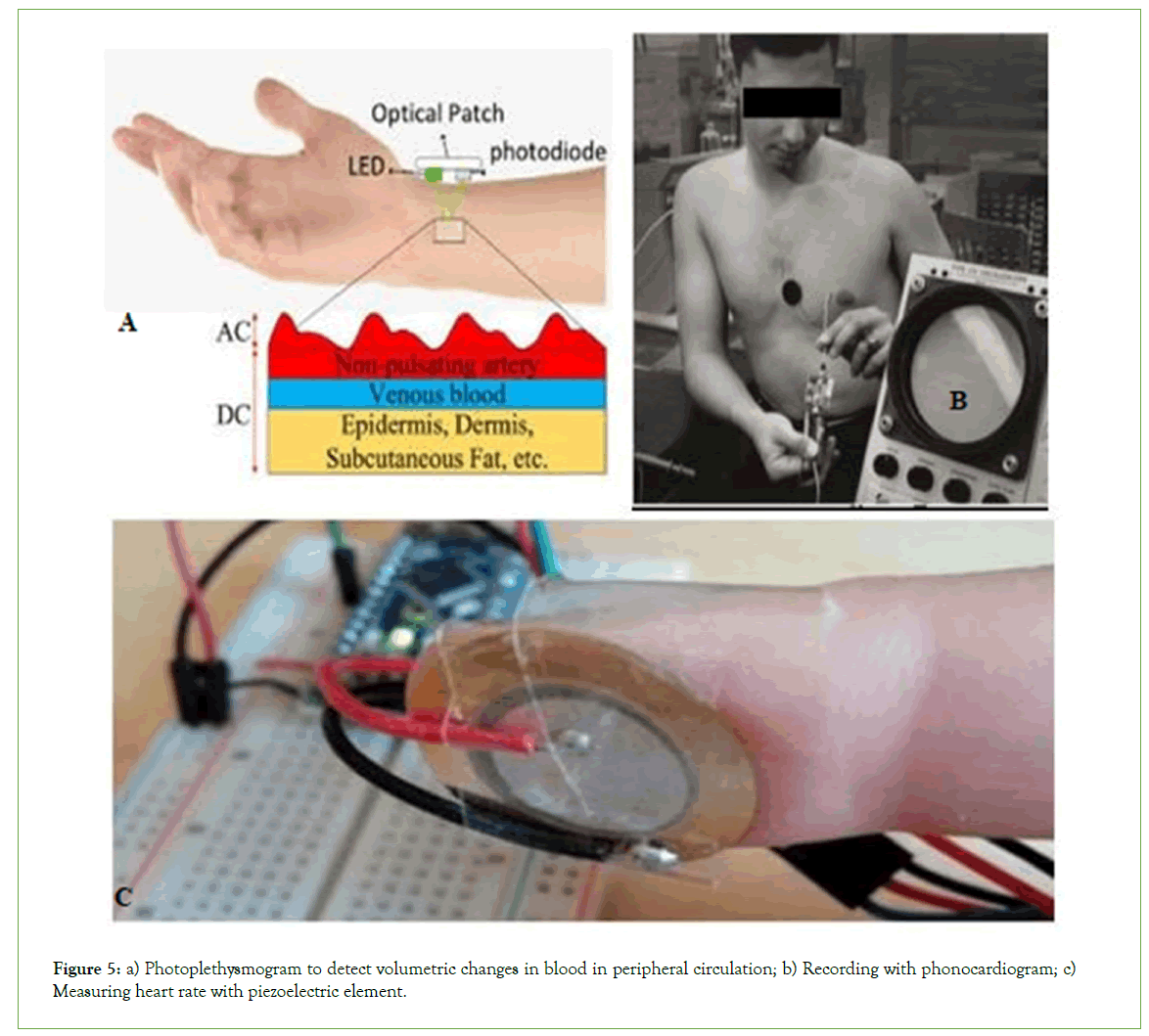
Figure 5: a) Photoplethysmogram to detect volumetric changes in blood in peripheral circulation; b) Recording with phonocardiogram; c) Measuring heart rate with piezoelectric element.
Currently, with the available technology, sensors and amplifiers, we have the ability to receive the sound of the animal’s heart from the stomach, but placing the sensor box on the stomach of the animal for a long time is not normal and may be impossible. For this reason, we have tried to find a way to take the animal’s pulse from the cow’s neck.
Applicable theory
Thomas was working on a project that detected whether water was flowing in a pipe with several piezoelectric sensors. Out of curiosity, he stuck the sensor to his finger, and to his surprise, all the values his microcontroller was spitting out were very noise-free versions of his heart rate. He found this to be a much simpler solution to measuring heart rate.
History of heart sound processing through electrical voltage
Awareness of the sounds produced by the heart dates back to Robert Hooke (1703-1635), who wrote:
“It may also be possible to discover the internal movements and actions of bodies-whether animal, vegetable, or mineral. The sound they make”.
Common sensors for measuring human heart rate are made of optical system. The sensor shines light on the skin and measures its reflection with a light detector. The oxygen in hemoglobin has a special property, that is, it can absorb a certain amount of green light. The more oxygen in the blood, the redder the blood, which increases the rate of light absorption and reduces reflection. As blood is pumped through the finger veins, the amount of reflected light changes, creating an oscillating waveform. By measuring this wave, we can read the heartbeat.
Conceptual model
Fortunately, with the available capabilities, we can listen to the sound of cardiac stimuli from the cattle using a sound sensor instead of using an optical pulse sensor. With this method, the thickness of the animal’s skin is no longer a challenge for us because we are using frequency instead of light. Amplifying and directing sound is feasible for us, and if necessary, we can also utilize ultrasonic assistance.
The only remaining need is to amplify the received sound. One of the methods for sound amplification is softwarebased, which is quite suitable for our purpose but not enough.
The complementary method and the main idea to amplify the received sound involve using a sound diaphragm embedded in the bottom part of the sensor box, which will be placed on the collar to capture the sound of the animal’s body.
This diaphragm chamber is connected to the animal’s body like a stethoscope, it receives the sound of the animal’s body and transmits it to the piezoelectric through a tube.
In the next part of the circuit, the received sound will be converted into electric waves and ready for processing. The received sound will be in the form of frequency, after processing we will be able to obtain systolic and diastolic and draw the corresponding diagrams (Figure 6).

Figure 6: a) The part below the device that connects to the animal’s body; b) The internal view of the device and how the sound is transmitted from the diaphragm to the piezo; c) Detect heartbeat via piezoelectric.
For using the acoustic wave sensitive sensor in veterinary related projects, microphones are available for animal health and livestock research. One of the most famous microphones sensitive to sound waves for livestock is the Electret microphone. Features of this microphone: Suitable dimensions for connecting to the diaphragm designed to optimally absorb the internal sounds of the animal’s body, high sensitivity to sound waves, ideal for recording animal sounds.
Modules used in the desired device
• Wemos D1 mini
• Audio sound sensor module microphone, KY-038
• Wemos D1 lithium battery shield module
• LM35 temperature sensor
• Lithium battery
• Flexible solar panel (Figure 7).
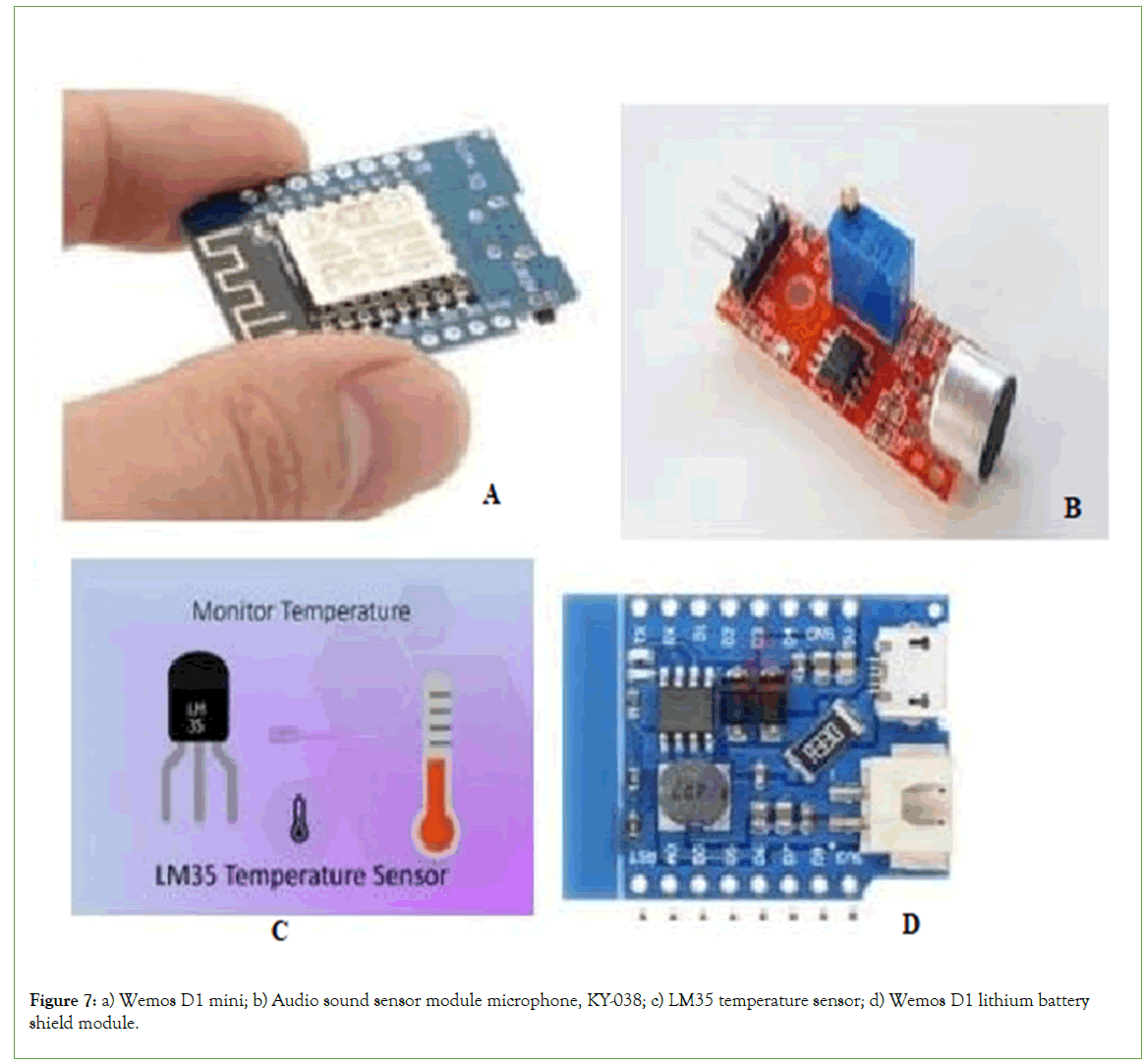
Figure 7: a) Wemos D1 mini; b) Audio sound sensor module microphone, KY-038; c) LM35 temperature sensor; d) Wemos D1 lithium battery shield module.
Circuit schematic
Circuit PCB and circuit connection diagram are designed and produced. The raw data received from the animal will be sent to the hub server by the Wi-Fi system and will be processed and stored in the cloud. The processed information will be converted into the necessary diagrams and will be sent to the local system or to their mobile phones. When necessary, the required alarms can be sent in the form of SMS, email, notification and even through social networks.
Device box prototyping by 3D printing
The 3D design of the sensor box is prepared and produced according to the dimensions and needs of the electronic components as well as the animal’s body, using 3D printing technology.
Neck collar design for the device
A collar was needed for the manufactured device and a leather strap was used for testing (Figure 8).
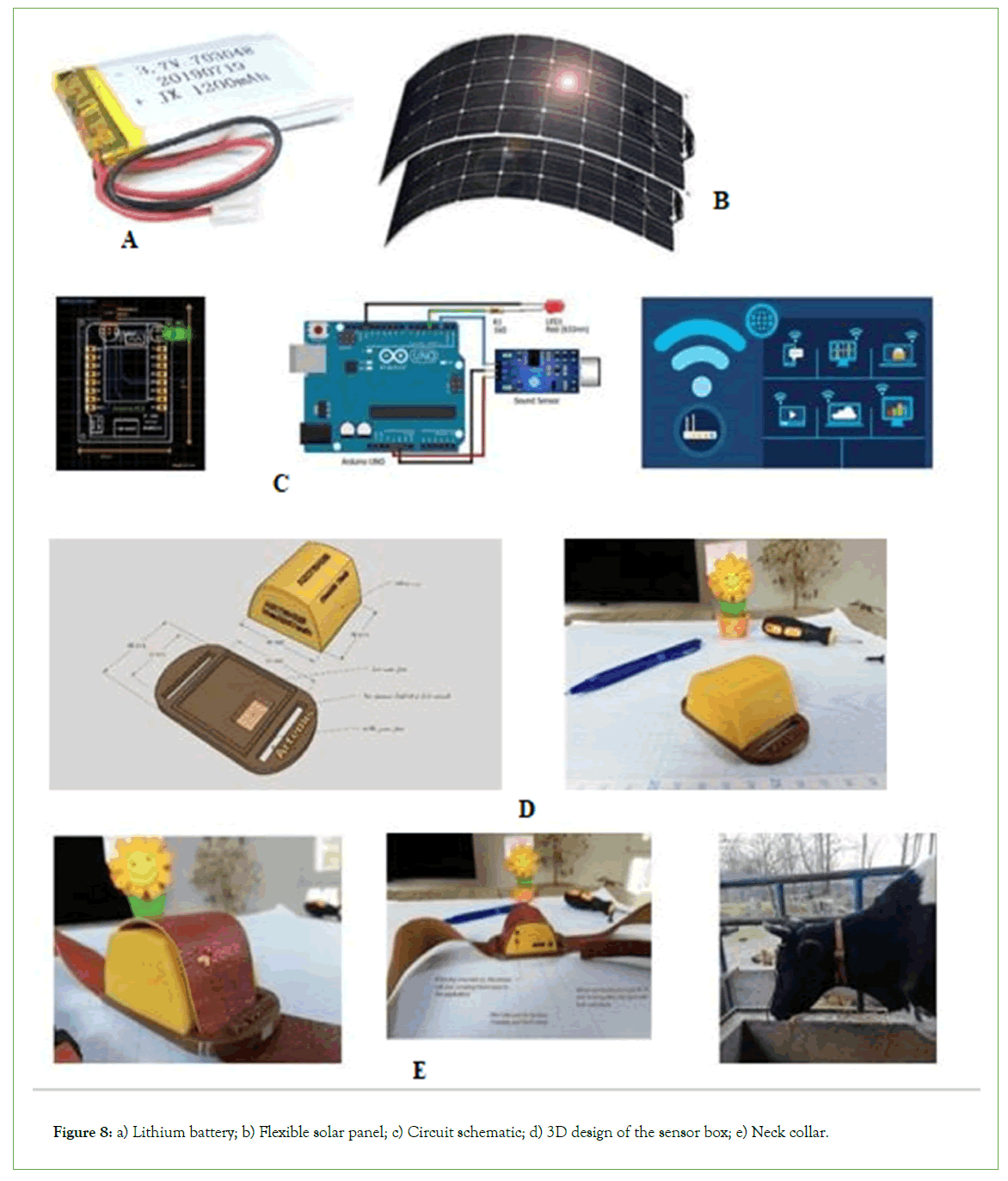
Figure 8: a) Lithium battery; b) Flexible solar panel; c) Circuit schematic; d) 3D design of the sensor box; e) Neck collar.
To get the information that can be used from the blood system of the cattle, the image below shows the blood vessels of the cow.
As shown in the picture, the best access to the vein is in the neck area. There are two areas in the neck of animals where the vein, trachea and esophagus can be accessed. One is close to the animal’s feet and is very close to the heart, and the other is close to the head and mouth, which is very good for listening to the sounds related to the animal itself, feeding and breathing. Choosing the best area for collar belt design will be determined after future tests.
When designing the collar, we must determine the optimal way to place the sensor in the best position. The mode where the sensor is placed exactly in the desired place and on the vein and at the same time creates the least possible pressure for the cattle (Figure 9).
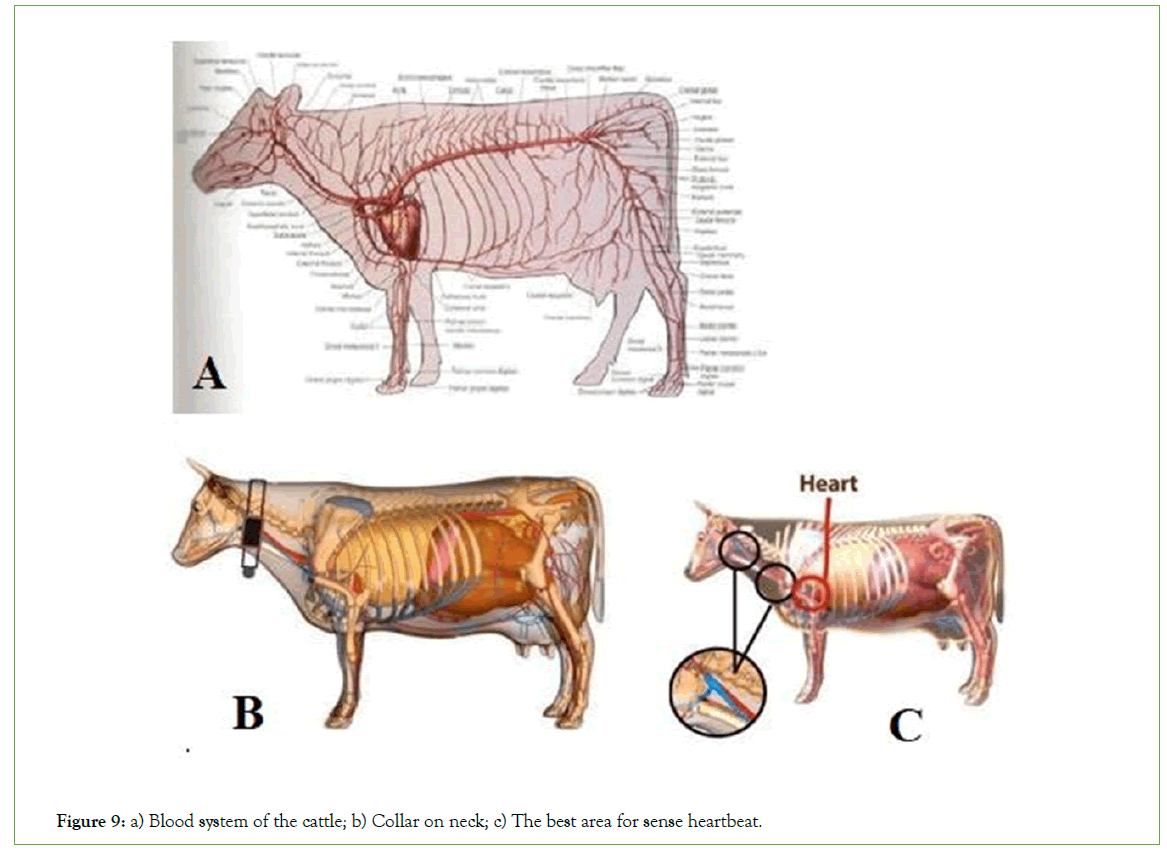
Figure 9: a) Blood system of the cattle; b) Collar on neck; c) The best area for sense heartbeat.
The processing of received sounds requires energy, and because our device supplies its energy from the battery, we are facing energy limitations, and the design of energy consumption should be optimized and the minimum processing should be done in the microcontroller. For this reason, we will send the received raw frequency to the processing center or server through the Wi-Fi system so that the processing, analysis and storage tasks are done there, and then it is displayed to the user for review.
Also, to increase battery life, a flexible solar panel can be used on the door of the sensor compartment and even on the length of the collar strap (Figure 10).
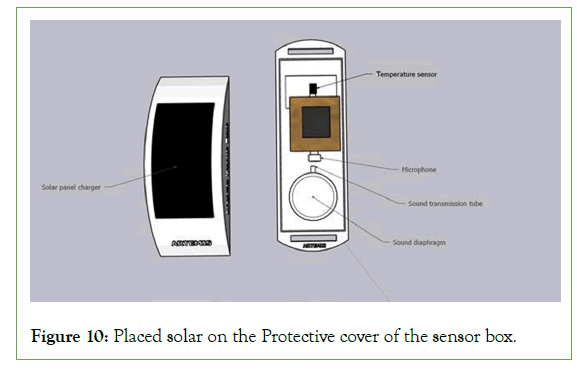
Figure 10: Placed solar on the Protective cover of the sensor box.
Challenges ahead
Foreseeable challenges in this field encompass constraints and issues that may arise during operations in agricultural settings with external animals. Factors such as environmental noise, animal movements, and resistance to wearable devices can be anticipated factors. Properly designed collars tailored to the animal’s body minimize animal resistance.
The presence of a diaphragm renders the sound sensor polarized, filters environmental sounds to a large extent, and captures body sounds more clearly.
The most significant challenge ahead lies not in external noises but rather in various internal achieved sounds of the animal’s body. These may include respiratory sounds, sounds produced by the cow, eating noises, rumination, and so forth.
This scenario has both pros and cons
• The advantage lies in the fact that with the same sensor, we can obtain a wealth of information in various scenarios. For example: sounds related to cardiac and vascular problems, respiratory issues, digestive problems, unusual sounds indicating animal distress, unpredictable sounds occurring during unusual events, and so on.
• The downside of the challenge is receiving different sounds of livestock bodies. It is necessary to filter the received sound first using sound processing software systems and specific algorithms and also, by using artificial neural networks and AI technology to recognize the frequency associated with each movement. After sound filtration and categorization of frequencies related to the heart, lungs, etc., we will be able to use the received information to detect livestock health.
Optimal use of received information
Considering the previous steps that have led to obtaining segmented sound information from livestock, we now have several sets of different and valuable frequency data. For example:
• Sounds related to the heart and blood vessels
• Sounds related to the respiratory system
• Sounds related to the digestive system
• Sounds produced by the animal itself
• Environmental abnormal sounds
Each of these subcategories can represent a group of important information after processing. For example, in the case of sounds related to digestion, we can record feeding time, rumination, and resting time for the animal. Also, signs of discomfort during swallowing and even obstruction of the airway or esophagus can be detected by the received sounds. Similarly, other items can provide a lot of information, and ultimately, hundreds of cases that are recordable and processable can be identified.
Furthermore, it is possible to personalize health information for each individual animal by processing and storing the received data from each animal in the initial minutes of connection and considering a specific data file for each animal, synchronized with the moods and physical characteristics of that particular animal. From now on, we can compare the animal’s information with the data stored for that animal, and in case of any interference, quickly become aware of changes in the animal’s condition. Of course, in case of stability, after comparing the above conditions with the stored data for all animals and system confirmation, if there is no discrepancy, the animal’s health indicator will move to the stable phase.
For example: A cow’s heart rate in a general state is 60, but perhaps a cow’s normal heart rate in that specific cow is 58. In our initial connection, we observe the number 58. If the received number is not significantly different from the general norm, we consider a heart rate of 58 as the health range for this animal. Based on this algorithm, other items such as temperature, respiration, etc., will also be manageable.
Results
Nowadays, smart veterinary stethoscopes have found a great place in the field of cardiology and disease diagnosis due to their ability to increase the sound (up to 17 times). These stethoscopes have sensors that amplify the sounds received through the diaphragm and provide a clear sound to the listener.
To obtain the best area of the animal’s body for listening to the heartbeat and installing the device, as well as processing and ensuring the correctness of the proposed design, a simple test can be performed by phonocardiography. To do that, we only need a normal headset, a veterinary stethoscope, and a mobile phone. By connecting the diaphragm part of the stethoscope to the headset microphone, we can store the received sound in a mobile phone for processing and performing the necessary tests through machine learning and AI (Figure 11).
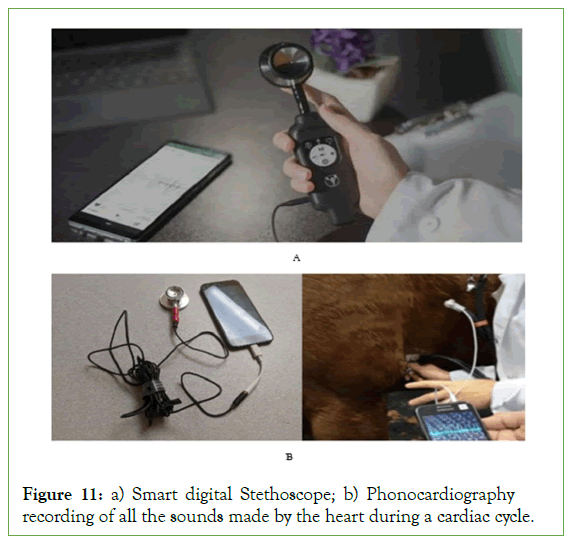
Figure 11: a) Smart digital Stethoscope; b) Phonocardiography recording of all the sounds made by the heart during a cardiac cycle.
Furthermore, it is possible to personalize health information for each animal by using machine learning and processing and storing the received data from each animal in the initial minutes of connection and considering a specific data file for each animal, synchronized with that particular animal’s moods and physical characteristics. From now on, we can compare the animal’s information with the data stored for the same animal, and in case of any interference, quickly become aware of changes in the animal’s condition. Of course, in case of stability, after comparing the above conditions with the stored data for all animals and system confirmation, if there is no discrepancy, the animal’s health indicator will move to the stable phase.
For example: A cow’s heart rate in a general state is 60, but perhaps a cow’s normal heart rate in that specific cow is 58. In our initial connection, we observe the number 58. If the received number is not different from the general norm, we consider a heart rate of 58 as the health range for this animal. Based on this algorithm, other items such as temperature, respiration, etc., will also be manageable via machine learning.
The strategy of using artificial intelligence technologies, artificial neural networks, and machine learning to perform the above steps as well as how to use the Internet of Things to transfer information, and also the results of the tests will be gradually added to this part of the article.
Discussion
In previous research, good and promising results have been obtained from listening and receiving the cow’s pulse using a stethoscope to amplify the sound received in the cow’s back (Figure 12).
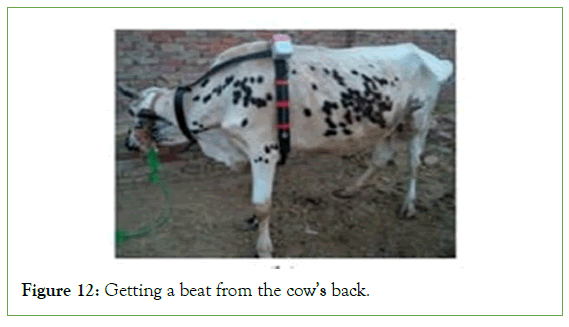
Figure 12: Getting a beat from the cow’s back.
In order to be able to use this method, it is necessary that the above system is located on the animal’s body all the time and has the best possible performance considering the comfort of the animal. The oldest and best wearable device is the collar, and we are trying to use the phonocardiography system on the neck of the animal in the initial stage.
In the next step, by using and relying on the previous research that is listed under this paragraph, the necessary research and tests will be carried out to reach a more advanced product by upgrading the above systems and changing the required parameters from human models to the system. It can be used subcutaneously in livestock, to achieve a significant improvement for livestock monitoring and permanent micro controller charging through the piezoelectric nano-generator mechanism.
• Automatic heart rate detection during sleep using on-chip audio recordings from a wireless acoustic sensor [9].
• Blood pressure control system based on ultrasonic system [10].
• Breathing control system using a microelectromechanical system [11].
• A miniature, flexible and wearable sound sensor that records the physiological waves produced in the human body and allows the user to monitor human health [12].
• Diagnosis and monitoring of pregnancy in cattle through the processing of fetal sound signal and ultrasound [13] (Figure 13).
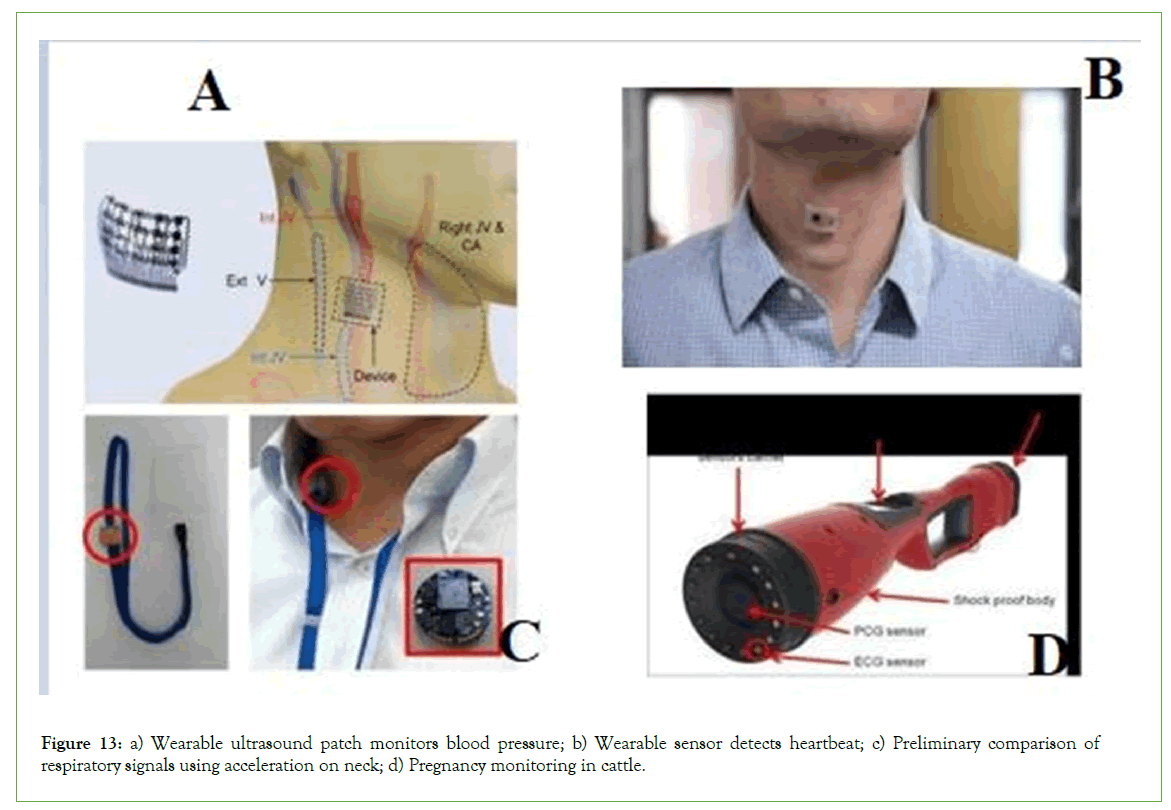
Figure 13: a) Wearable ultrasound patch monitors blood pressure; b) Wearable sensor detects heartbeat; c) Preliminary comparison of respiratory signals using acceleration on neck; d) Pregnancy monitoring in cattle.
• Identifying the piezoelectric signal to detect the heartbeat [14] (Figure 14).
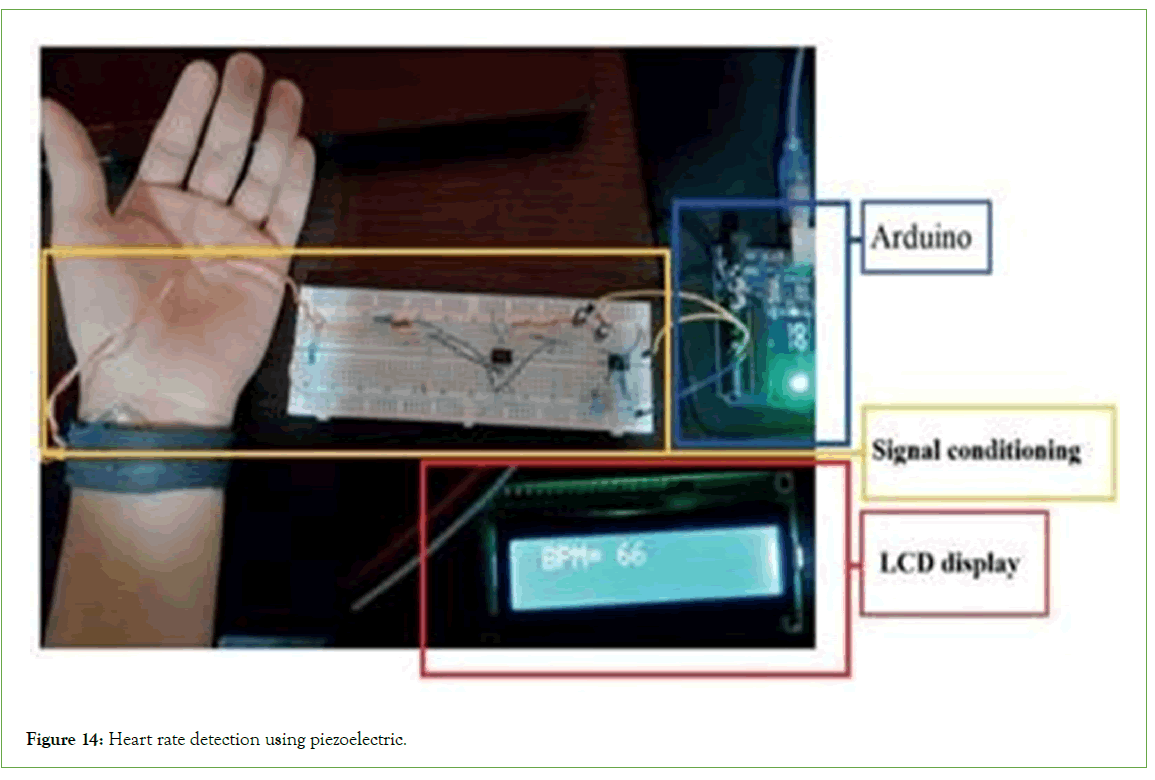
Figure 14: Heart rate detection using piezoelectric.
• Setting up the heart pacemaker by the electrical energy produced by the piezoelectric nano generator from the heart’s movements [15] (Figure 15).
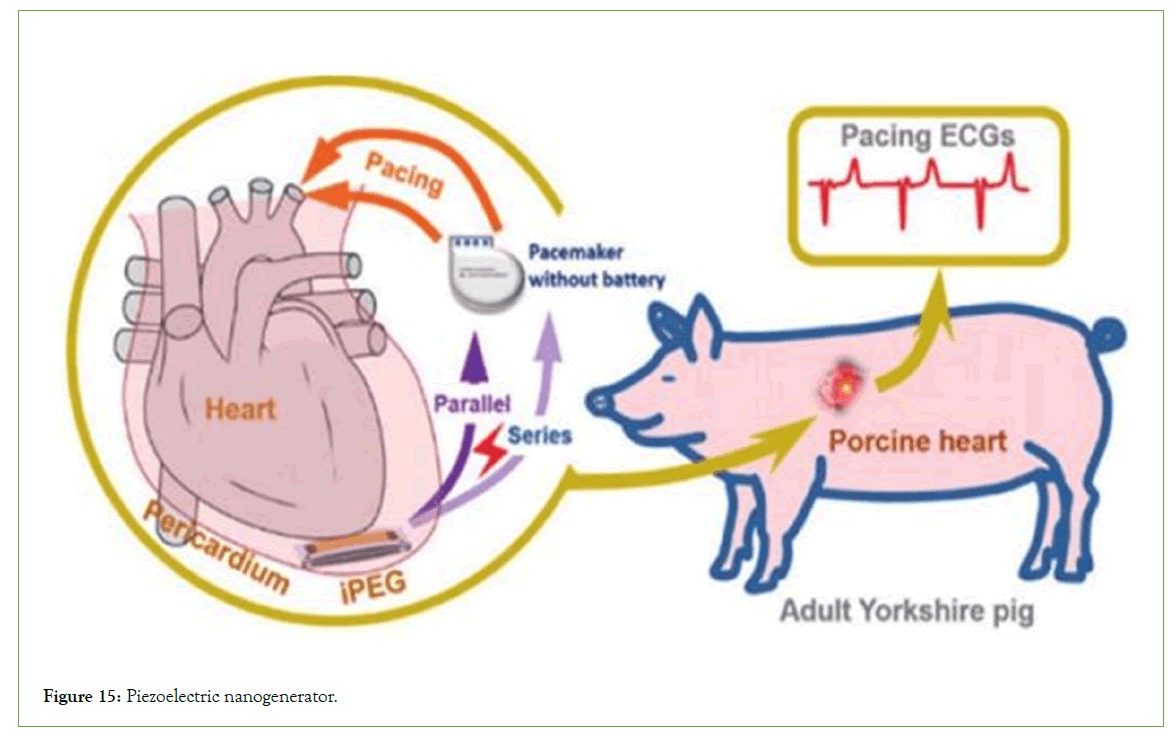
Figure 15: Piezoelectric nanogenerator.
Needs and future research
The effective use of online pulse detection sensor systems can significantly assist in improving the health care system for livestock in farms. This system provides farmers with the ability to monitor the health status of cattle more accurately and hygienically, ultimately leading to increased production efficiency and reduced farming costs. A wireless collar system with sensors for temperature, humidity, accelerometer, pulse, etc., along with a central data processing system, has been developed and is ready for use. Our main research focuses on prototyping a diaphragm and sensor housing compatible with the sensors needed to capture the internal body sounds of animals such as heartbeat, respiration, nutrition, etc. Furthermore, the use of Artificial Intelligence (AI) and Artificial Neural Networks (ANN) for processing received sounds for monitoring livestock health through livestock body sounds and the use of Internet of Things (IoT) technology for data integration will be employed.
If necessary, the possibility of integrating ultrasonic and electrocardiogram systems are available. To upgrade the system, we can utilize ultrasonic systems to construct a microcontroller for monitoring heart rate and blood pressure, as well as piezoelectric devices for charging the module from energy received from vein vibrations. The subcutaneous module will be placed near the main neck vein of the animal for optimal use.
Achieving these goals has required months of effort and research by engineers and farmers, as well as the assistance and collaboration of veterinarians, to reach a good level of awareness. Now, for faster progress and to enhance the quality of processing data received from sensors, a more detailed examination of farmers’ needs, identification of suitable body areas for monitoring different types of animals, and the detection and separation of sounds related to the heart, respiratory system, digestive system, etc., are necessary. Collaborating with specialists, farmers, veterinarians, and universities for professional sound processing and the construction of subcutaneous modules is invaluable and essential to us.
Conclusion
This article aims to present a novel and efficient solution in the field of livestock health care using wireless sensor technologies, IoT, Artificial Intelligence (AI), and Artificial Neural Networks (ANN). In existing collar-based systems, temperature and accelerometer sensors have been used for monitoring cattle health, and efforts to obtain heart rate information to complement this system are ongoing.
The use of light-based sensors for receiving pulse information from animals has been somewhat successful, but it has not yet reached the required quality due to the thickness of animal skins. In this article, sound detection and processing technology is considered instead of light for receiving information related to animal health. Initial experiments indicate a high probability of achieving a novel system for upgrading health monitoring systems. A system that provides the ability to improve the health and productivity of cattle and provides farmers with an effective tool for optimal farming management.
Wider collaboration with scientific and research centers, as well as closer communication with livestock health companies, universities, and researchers in the field of animal husbandry and veterinary medicine internationally, will greatly assist in improving experiments and accelerating research progress.
References
- Swain KB, Mahato S, Patro M, Pattnayak SK. Cattle health monitoring system using Arduino and LabVIEW for early detection of diseases. In 2017 Third International Conference on Sensing, Signal Processing and Security (ICSSS). IEEE. 2017:79-82.
- Create an Iot-based smart collar digital tool, lecturers and students of asean’s best private university help increase cattle growth productivity at cv sapi sport. 2022.
- Cui Y, Zhang M, Li J, Luo H, Zhang X, Fu Z. WSMS: Wearable Stress Monitoring System based on IoT multi-sensor platform for living sheep transportation. Electronics. 2019;8(4):441.
- Castillo DC, Bulayungan A, Lapie JC, Livida DM, Macatangay B, Sangalang KF, et al. Cattle Icare Monitoring System (CIMS): Remote monitoring of cattle’s heart rate, temperature, and daily steps with smart sprinkler system. J Intell Comput. 2023:67-76.
- Rajapakse T, Maduranga M, Dissanayake M. IoT-enabled cattle health and location monitoring system. Int J Appl Sci Dev. 2022;1:64-74.
- Miller M, Byfield R, Crosby M, Schiltz P, Johnson PJ, Lin J. A wearable photo plethysmography sensor for non-invasive equine heart rate monitoring. Smart Agric. Technol. 2023;5:100264.
- Arshad J, Rehman AU, Othman MT, Ahmad M, Tariq HB, Khalid MA, et al. Deployment of wireless sensor network and iot platform to implement an intelligent animal monitoring system. Sustainability. 2022;14(10):6249.
- Abdanan Mehdizadeh S, Sari M, Orak H, Pereira DF, Nääs ID. Classifying chewing and rumination in dairy cows using sound signals and machine learning. Animals. 2023;13(18):2874.
[Crossref] [Google Scholar] [Pubmed]
- Tomaszewska JZ, Młyńczak M, Georgakis A, Chousidis C, Ładogórska M, Kukwa W. Automatic heart rate detection during sleep using tracheal audio recordings from wireless acoustic sensor. Diagnostics. 2023;13(18):2914.
[Crossref] [Google Scholar] [Pubmed]
- Wearable ultrasound patch monitors blood pressure. Nat Biomed Eng. 2018;2:687-695
- Kano S, Mekaru H. Preliminary comparison of respiratory signals using acceleration on neck and humidity in exhaled air. Microsyst Technol. 2021;27(1):1-9.
- Wearable sensor detects heartbeat and allows voice control of remote devices. 2016.
- Gargiulo GD, Shephard RW, Tapson J, McEwan AL, Bifulco P, Cesarelli M, et al. Pregnancy detection and monitoring in cattle via combined foetus electrocardiogram and phonocardiogram signal processing. BMC Vet Res. 2012;8:1-10.
[Crossref] [Google Scholar] [Pubmed]
- Cepeda E, Peluffo-Ordóñez DH, Rosero-Montalvo P, Becerra MA, Umaquinga-Criollo AC, Ramírez L. Heart rate detection using a piezoelectric ceramic sensor: Preliminary results. Revis Bionatura. 2022;7(3):30.
- A review on the use of medicinal plants in physiological disorders caused by air and space travel. 2010.
Citation: Sotoudeh M, Alavi N, Zarrineh A (2024) Improving Online Livestock Health Monitoring System using Machine Learning, AI, ANN, IoT and Sound Based Technologies: A Pilot Study. Int J Swarm Evol Comput. 13:369.
Copyright: © 2024 Sotoudeh M, et al. This is an open-access article distributed under the terms of the Creative Commons Attribution License, which permits unrestricted use, distribution, and reproduction in any medium, provided the original author and source are credited.
